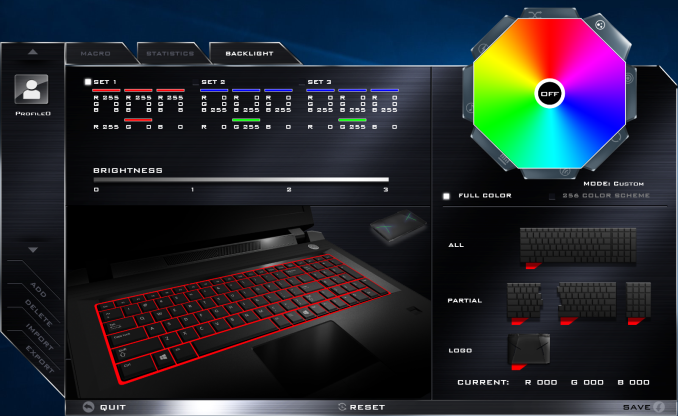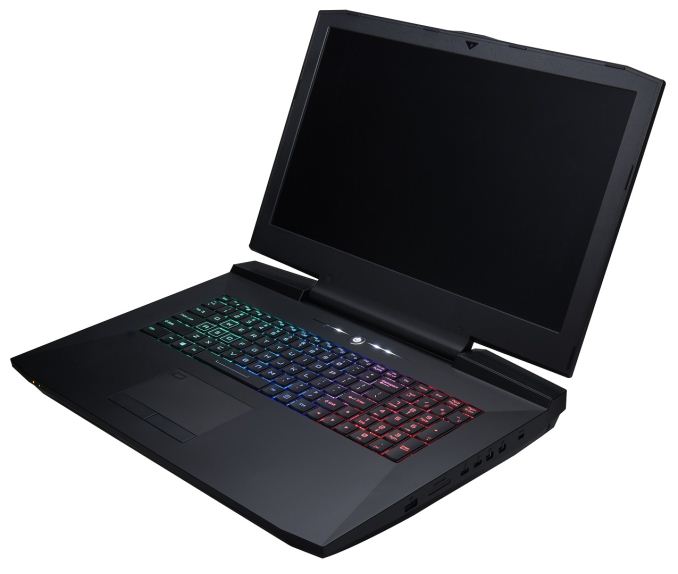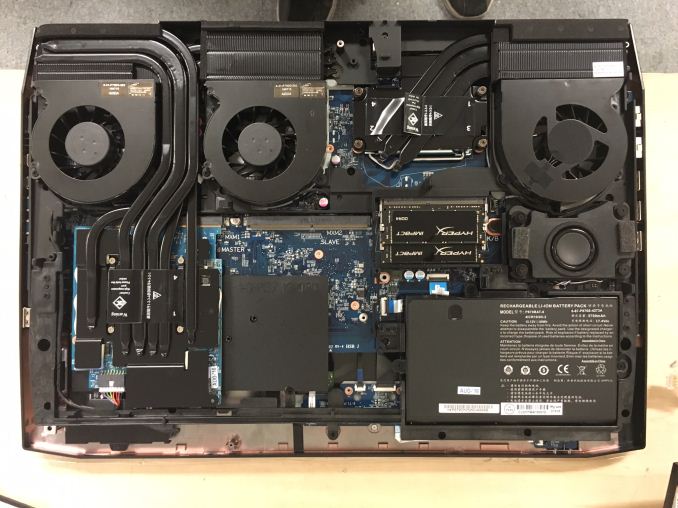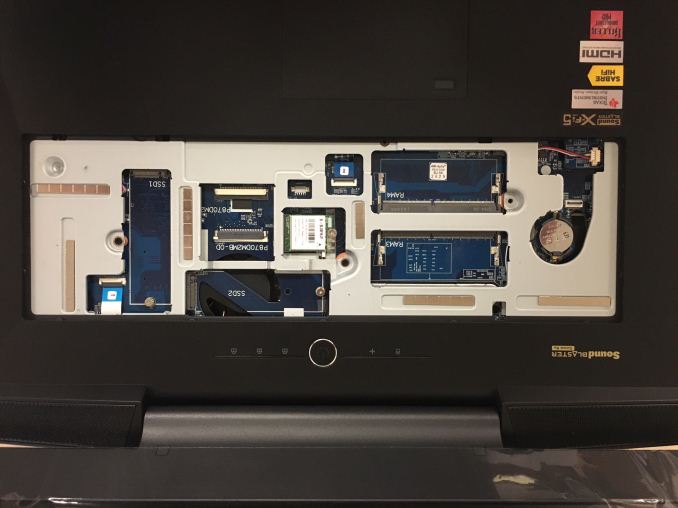The Clevo P870DM2 / Mythlogic Phobos 8716 Laptop Review: DTR With GTX 1080
by Brett Howse on October 27, 2016 2:00 PM ESTDesign
This desktop replacement really puts the spotlight on performance, but the lack of premium materials in the case may dissuade some. Mythlogic and Clevo have still offered up a design that is pleasing to the eye, without being adorned with a lot of the excessive furnishings that are on many gaming laptops. The color scheme is simply black, with black vents on the back, a black top, and black chassis. The exception to this is the RGB backlit cross hatches on the top, which can be set to seven colors, or turned off, through the MYTH Control Center. The software also allows you to set pulsing lights, random colors, and more. The design isn’t going to win awards, but for a device that doesn’t need to be in your hand very often, it is certainly functional. The black plastic is fairly resilient to fingerprints, and the chassis itself is nice and rigid, although at almost two inches thick, I suppose it should be.
The same MYTH Control Center handles the keyboard duties. Here there a lot more options to customize the keyboard. There is full RGB backlighting on the keyboard, and with the help of a color wheel, or manual entry of the RGB values, you can select any color you like. There are no per-key choices here, but the keyboard is split into three zones, with left and right of the keyboard, plus the number pad, and all able to be set to different colors. The software shows a clean break between the zones, but there is quite a bit of light bleed between the zones, so in the middle the colors are a bit mixed. I don’t mind this on the keyboard, but it would be nice if the number pad was able to be separated. Also, and this is a list of personal preferences, I would rather have one zone for the keyboard, one for the number pad, and then one for the WASD keys if they are going to do zones. There are also modes to have the keyboard flash and do other funky things, much like other companies have. These modes would be ok for a demo, but are not very suitable for day to day use.
Let’s talk about the keyboard itself. For those that recall our last Clevo DTR review, the P750ZM, the keyboard in this version is pretty much identical. The keyboard is much more old school than most of the island style we would see these days, and overall it’s not a great experience. I tend to focus a lot on the keyboard, perhaps more than others, but this keyboard is really sub-par by today’s standards. The key travel is very shallow, which is even more puzzling considering how thick this laptop is, and the key shape makes it difficult to determine the edges of keys when touch typing. I really think Clevo could do a better job here. Even though this is a DTR, plenty of people are likely to use this keyboard even if they don’t use the trackpad, so some engineering here would go a long way.
The Synaptics track pad is by far less important on a device like this, since I would assume most buyers would be using it with a dedicated mouse most of the time. But the track pad is usable, with a decent surface that I had no issues tapping or doing multi-touch gestures on. The dedicated buttons make it a bit more serviceable for gaming as well, even if they do take up space that could otherwise be used for the touch surface. The most interesting feature on this trackpad though is the integrated Windows Hello capable fingerprint reader. It is a touch model, not a swipe, and although I would prefer it to be a bit larger, it works quiet well and makes for a quick login. I think this is a great way to get a fingerprint reader into a laptop, and I hope others take note.
As mentioned on the first page, there are an abundance of ports on this notebook, meaning you pretty much can use it ask a desktop if needed. The inclusion of not one but two USB 3.1 Type-C ports with Thunderbolt 3 means there is plenty of expandability if needed, but there are also five additional Type A ports for more common devices, along with plenty of video outputs and audio inputs. There are also two Ethernet ports, and a SD card slot which does hold the card completely inside the laptop, so it can be used permanently if needed.
For some, the exterior is important, but for other buyers, it’s going to be internal access which is a deal breaker, and happily Clevo offers a pretty nice layout for upgrades. The bottom can be removed for access to the MXM cards, and a couple of the RAM slots. The keyboard can be removed to access the other two RAM slots, as well as two M.2 SSD slots, and there is also room for two 2.5-inch SATA drives as well. This kind of expandability should help to extend the longevity of the device.
Overall the Mythlogic Phobos 8716 / Clevo P870DM2 does not hit the high bar of more expensive devices when it comes to design and premium materials, but it is very expandable, and even upgradable.

















61 Comments
View All Comments
BrokenCrayons - Thursday, October 27, 2016 - link
Minor details...the MYTH Control Center shows an image of a different laptop. It struck me right away because of the pre-Pentium MMX Compaq Presario-esque style hinge design.As for Pascal, the performance is nice, but I continue to be disappointed by the cooling and power requirements. The number of heat pipes affixed to the GPU, the fact that it's still reaching thermal limits with such cooling, and the absurd PSU requirements for SLI make it pretty obvious the whole desktop-class GPU in a laptop isn't a consumer-friendly move on NV's part. Sure it cuts back on engineering, manufacturing, and part inventory costs and results in a leaner organization, but it's hardly nice to people who want a little more than iGPU performance, but aren't interested in running up to the other extreme end of the spectrum. It's interesting to see NV approach the cost-cutting measure of eliminating mobile GPU variants and turning it into a selling point. Kudos to them for keeping the wool up on that aspect at least.
The Killer NIC is something I think is a poor decision. An Intel adapter would probably have been a better choice for the end user since the benefits of having one have yet to be proven AND the downsides of poor software support and no driver flexibility outweigh the dubious claims from Killer's manufacturer.
ImSpartacus - Thursday, October 27, 2016 - link
Nvidia just named their mobile GPUs differently.Fundamentally, very little has changed.
A couple generations ago, we had a 780mx that was based on an underclocked gk104. Nvidia could've branded it as the "laptop" 770 because it was effectively an underclocked 770, just like the laptop 1080 is an underclocked 1080.
But the laptop variants are surely binned separately and they are generally implemented on the mxm form factor. So there isn't any logistical improvements just by naming their laptop GPUs differently.
The_Assimilator - Thursday, October 27, 2016 - link
"The number of heat pipes affixed to the GPU, the fact that it's still reaching thermal limits with such cooling, and the absurd PSU requirements for SLI make it pretty obvious the whole desktop-class GPU in a laptop isn't a consumer-friendly move on NV's part."nVIDIA is doing crazy things with perf/watt and all you can do is complain that it's not good enough? The fact that they can shoehorn not just one, but TWO of the highest-end consumer desktop GPUs you can buy into a bloody LAPTOP, is massively impressive and literally unthinkable until now. (I'd love to see AMD try to pull that off.) Volta is only going to be better.
And it's not like you can't go for a lower-end discrete GPU if you want to consume less power, the article mentioned GTX 1070 and I'm sure the GTX 1060 and 1050 will eventually find their way into laptops. But this isn't just an ordinary laptop, it's 5.5kg of desktop replacement, and if you're in the market for one of these I very much doubt that you're looking at anything except the highest of the high-end.
BrokenCrayons - Thursday, October 27, 2016 - link
Please calm down. I realize I'm not in the target market for this particular computer or the GPU it uses. I'm also not displaying disappointment in order to cleverly hide some sort of fangirl obsession for AMD's graphics processors either. What I'm pointing out are two things:1.) The GPU is forced to back off from its highest speeds due to thermal limitations despite the ample (almost excessive) cooling solution.
2.) While performance per watt is great, NV elected to put all the gains realized from moving to a newer, more efficent process into higher performance (in some ways increasing TDP between Maxwell/Kepler/etc. and Pascal in the same price brackets such as the 750 Ti @ 60W vs the 1050 Ti @ 75W) and my personal preference is that they would have backed off a bit from such an aggressive performance approach to slightly reduce power consumption in the same price/performance categories even if it cost in framerates.
It's a different perspective than a lot of computer enthusiasts might take, but I much perfer gaining less performance while reaping the benefits of reduced heat and power requirements. I realize that my thoughts on the matter aren't shared so I have no delusion of pressing them on others since I'm fully aware I don't represent the majority of people.
I guess in a lot of ways, the polarization of computer graphics into basically two distinct categories that consist of "iGPU - can't" and "dGPU - can" along with the associated power and heat issues that's brought to light has really spoiled the fun I used to find in it as a hobby. The middle ground has eroded away somewhat in recent years (or so it seems from my observations of industry trends) and when combined with excessive data mining across the board, I more or less want to just crawl in a hole and play board games after dumping my gaming computer off at the local thrift store's donation box. Too bad I'm screen addicted and can't escape just yet, but I'm working on it. :3
bji - Thursday, October 27, 2016 - link
"Please calm down" is an insulting way to begin your response. Just saying.BrokenCrayons - Thursday, October 27, 2016 - link
I acknowledge your reply as an expression of your opinion. ;)The_Assimilator - Friday, October 28, 2016 - link
Yeah, but my response wasn't exactly calm and measured either, so it's all fair.BrokenCrayons - Friday, October 28, 2016 - link
"...so it's all fair."It's also important to point out that I was a bit inflammatory in my opening post. It wasn't directed at anyone in particular, but was/is more an expression of frustration with what I think is the industry's unintentional marginalization of the lower- and mid-tiers of home computer performance. Still, being generally grumpy about something in a comments box is unavoidably going to draw a little ire from other people so, in essence, I started it and it's my fault to begin with.
bvoigt - Thursday, October 27, 2016 - link
"my personal preference is that they would have backed off a bit from such an aggressive performance approach to slightly reduce power consumption in the same price/performance categories even if it cost in framerates."They did one better, they now give you same performance with reduced power consumption, and at a lower price (980 Ti -> 1070). Or if you prefer the combination of improved performance and slightly reduced power consumption, you can find that also, again at a reduced price (980 Ti -> 1080 or 980 -> 1070).
Your only complaint seems to be that the price and category labelling (xx80) followed the power consumption. Which is true, but getting hung up on that is stupid because all the power&performance migration paths you wanted do exist, just with a different model number than you'd prefer.
BrokenCrayons - Thursday, October 27, 2016 - link
You know, I never thought about it like that. Good point! Here's to hoping there's a nice, performance boost realized from a hypothetical GT 1030 GPU lurking in the product stack someplace. Though I can't see them giving us a 128-bit GDDR5 memory bus and sticking to the ~25W TDP of the GT 730. We'll probably end up stuck with a 64-bit memory interface with this generation.